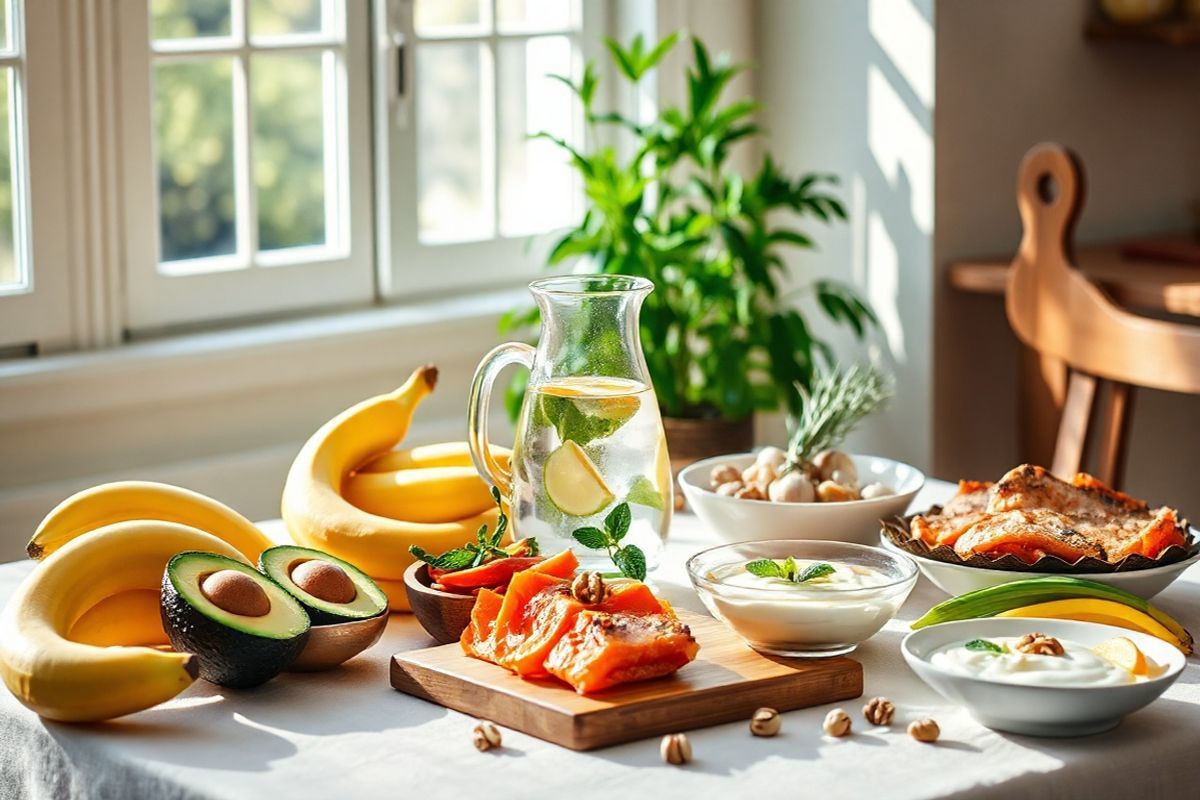Table of Contents
Understanding the Gut-Brain Axis: The Connection Between Diet and Mental Health

The gut-brain axis is an intricate communication network linking the gastrointestinal tract and the brain. This bidirectional communication significantly impacts not only digestion but also mood, behavior, and overall mental well-being. The enteric nervous system (ENS), often referred to as the “second brain,” comprises over 100 million neurons that line the gastrointestinal tract, enabling it to function independently to some extent while still sending critical signals to the central nervous system (Cleveland Clinic, 2023).
Research suggests that the gut microbiota plays an essential role in this communication. Gut bacteria produce neurotransmitters and other chemicals that can affect brain function and mood. For instance, an imbalance in gut bacteria can lead to mental health issues, such as anxiety and depression, which are often reported by individuals with gastrointestinal disorders like ulcerative colitis (Hopkins Medicine, 2023).
Moreover, dietary choices can influence both gut health and mental health. Foods rich in fiber, probiotics, and anti-inflammatory properties can foster a healthy gut microbiome, thereby enhancing the gut-brain connection. Understanding this relationship is crucial for individuals managing ulcerative colitis, as it underscores the importance of a diet that supports both gut health and emotional well-being.
The Importance of Food Logging for Ulcerative Colitis Management
Food logging is a powerful tool for individuals with ulcerative colitis (UC). Keeping a detailed record of food intake helps patients identify which foods trigger symptoms and which ones promote healing. Since ulcerative colitis can vary in severity, and individuals may react differently to certain foods, a personalized food log can provide insights essential for effective management.
Research indicates that dietary modifications can significantly impact the disease course in patients with ulcerative colitis. For example, some studies suggest that specific diets, like the low-FODMAP diet, can alleviate symptoms in certain individuals (Chim et al., 2023). Additionally, understanding one’s dietary triggers can lead to improved quality of life and reduced flares, making food logging an invaluable practice for anyone navigating the complexities of UC.
Food logs can also provide healthcare professionals with critical data, helping them tailor treatment plans based on individual dietary responses. This collaborative approach can enhance communication between patients and healthcare providers, leading to better outcomes.
Essential Tips for Maintaining an Effective Food Log

To create an effective food log, consider the following tips:
-
Be Consistent: Log your food intake daily, ideally at the same time each day. Consistency helps in identifying patterns.
-
Be Detailed: Include not only what you eat but also portion sizes, preparation methods, and any sauces or dressings. Note the time of consumption and your mood or stress levels at that time.
-
Use an App or Journal: Choose a method that works for you. Digital apps can provide reminders and make it easier to track your intake, while a simple notebook can be a more personal approach.
-
Review Regularly: Set aside time weekly to review your food log. Look for patterns that emerge, identifying foods that correlate with symptom flares or improvements.
-
Consult Professionals: Share your food log with a dietitian or your healthcare provider. Their insights can help you make informed dietary choices.
-
Stay Open-Minded: Be willing to experiment with your diet. Introducing new foods and eliminating suspected triggers may provide valuable insights.
-
Focus on Whole Foods: Prioritize whole, unprocessed foods that are less likely to irritate your gut. Foods rich in fiber, omega-3 fatty acids, and antioxidants are generally beneficial.
Foods to Include and Avoid: A Guide for Ulcerative Colitis Patients
Foods to Include
- Lean Proteins: Skinless poultry, fish, tofu, and eggs are generally well-tolerated and provide essential nutrients.
- Healthy Fats: Foods rich in omega-3 fatty acids, such as salmon, walnuts, and flaxseeds, can have anti-inflammatory effects.
- Low-Fiber Fruits and Vegetables: While fiber is important, high-fiber foods can exacerbate symptoms during flare-ups. Opt for cooked carrots, bananas, applesauce, and avocados.
- Probiotics: Yogurt with live cultures and fermented foods like kefir can help maintain a healthy gut microbiome.
- Hydration: Staying hydrated is crucial, particularly if experiencing diarrhea. Water, clear broths, and electrolyte solutions are beneficial.
Foods to Avoid
- High-Fiber Foods: Nuts, seeds, whole grains, and raw vegetables can irritate the digestive tract during flare-ups.
- Dairy Products: Many individuals with UC may experience lactose intolerance, leading to bloating and diarrhea.
- Spicy Foods: Foods rich in spices can trigger symptoms for many individuals.
- Caffeine and Alcohol: These can stimulate the intestines and worsen diarrhea.
- Processed Foods: Foods high in additives and preservatives can lead to gut inflammation.
Analyzing Your Food Log: How to Identify Triggers and Patterns
Once you have maintained your food log for a few weeks, it’s time to analyze the data. Here are several strategies to help identify triggers and patterns:
-
Look for Correlations: Compare days when symptoms were worse with your food intake. Are there specific foods that consistently appear on those days?
-
Note the Severity: Record not just whether you experience symptoms, but also their severity. This can help gauge how strongly certain foods affect you.
-
Consider the Timing: Pay attention to when symptoms occur in relation to food intake. Symptoms may arise immediately or several hours later, influencing how you interpret the data.
-
Monitor Other Factors: Stress, sleep quality, and physical activity can also affect symptoms. Document these factors in your log to see how they correlate with your dietary choices.
-
Use a Color-Coding System: Implement a simple color system to mark foods that cause symptoms (red), those that seem neutral (yellow), and those that alleviate symptoms (green). This visual cue can help quickly identify patterns.
FAQ Section
Q: How long should I keep a food log?
A: It’s advisable to maintain a food log for at least four to six weeks to capture enough data for meaningful analysis.
Q: What should I do if I notice a pattern of symptoms associated with a specific food?
A: If you identify a food that triggers symptoms, consider eliminating it from your diet for a period and observe if your symptoms improve. Consult your healthcare provider for tailored advice.
Q: Can I include supplements in my food log?
A: Yes, it’s beneficial to log any supplements or medications, as they can also affect your gut health and symptoms.
Q: What if I have multiple food intolerances?
A: It may be helpful to work with a healthcare provider or dietitian specializing in gastrointestinal disorders to create an elimination diet plan that identifies trigger foods safely and effectively.
Q: Should I log my emotional state as well?
A: Yes, tracking your mood and emotional state can offer insights into how stress and mental health interact with your digestive symptoms.
References
- Cleveland Clinic. (2023). Brain Connection? Retrieved from https://my.clevelandclinic.org/health/body/the-gut-brain-connection
- Chim, S. M., Howell, K., Dronzek, J., Wu, W., Van Hout, C., Ferreira, M. A. R., Ye, B., Li, A., Brydges, S., Arunachalam, V., Marcketta, A., Locke, A. E., Bovijn, J., Verweij, N., De Tanima, T., Lotta, L., Mitnaul, L., LeBlanc, M., Carey, D. J., Melander, O., Shuldiner, A., Karalis, K., Economides, A. N., & Nistala, H. (2023). In vitro safety evaluation of dopamine D3R antagonist, R-VK4-116, as a potential medication for the treatment of opioid use disorder. PLOS ONE. Retrieved from https://doi.org/10.1371/journal.pone.0315569
- Hopkins Medicine. (2023). The Brain-Gut Connection. Retrieved from https://www.hopkinsmedicine.org/health/wellness-and-prevention/the-brain-gut-connection
- Cheng, Y., Cao, W., Guo, R., Chen, R., Li, X., Qian, D., & Xu, J. (2024). A comparative study of the quality differences and seasonal dynamics of flavonoids between the aerial parts and roots of Scutellaria barbata. Frontiers in Plant Science. Retrieved from https://doi.org/10.3389/fpls.2024.1497664
- Chinese Medical Association. (2024). Vascular cognitive impairment: Advances in clinical research and management. Chinese Medical Journal. Retrieved from https://pubmed.ncbi.nlm.nih.gov/11649275/
- Ulcerative Colitis. (2023). Retrieved from https://www.hopkinsmedicine.org/health/conditions-and-diseases/ulcerative-colitis
- Adipose tissue fibrosis: the unwanted houseguest invited by obesity. (2024). Retrieved from https://pubmed.ncbi.nlm.nih.gov/11648981/











